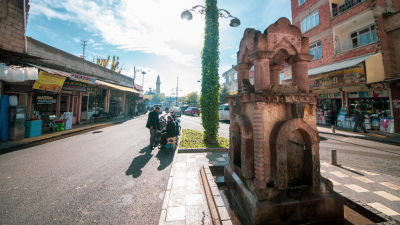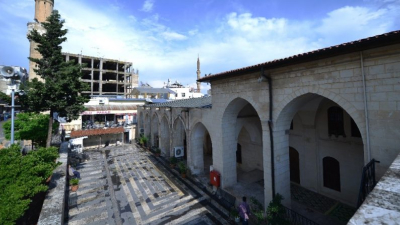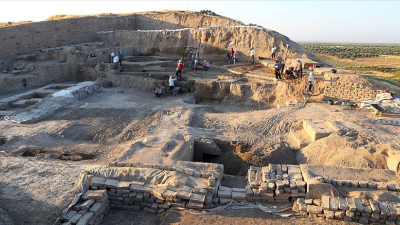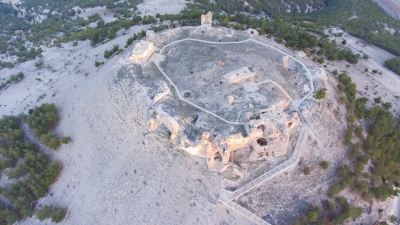 Kilis is a city located between the Southeast and the Mediterranean Region of Turkey, and has border with Syria. The excavations and several academic researches carried out around the city showed that Kilis was under Hittite rule in ancient times. The history of the city, which was ruled by Assyrians in 1100 BC, dates back to 3000 BC.
Kilis is a city located between the Southeast and the Mediterranean Region of Turkey, and has border with Syria. The excavations and several academic researches carried out around the city showed that Kilis was under Hittite rule in ancient times. The history of the city, which was ruled by Assyrians in 1100 BC, dates back to 3000 BC.
 The city was ruled by the Persians after the domination of Assyrians. Then, Seleucids, descendants of Alexander the Great, took over the rule of Kilis. Kilis, which was ruled by Roman in late BC years, was annexed to Byzantium as of 365 AD. The city, which was annexed to Islamic lands during the period of Hz. Omar, came under the rule of Ottomans following Ottoman expeditions in 1500s. Consisting of 6 neighborhoods during this period, Kilis started to rapidly develop during the period of Kanuni.
The city was ruled by the Persians after the domination of Assyrians. Then, Seleucids, descendants of Alexander the Great, took over the rule of Kilis. Kilis, which was ruled by Roman in late BC years, was annexed to Byzantium as of 365 AD. The city, which was annexed to Islamic lands during the period of Hz. Omar, came under the rule of Ottomans following Ottoman expeditions in 1500s. Consisting of 6 neighborhoods during this period, Kilis started to rapidly develop during the period of Kanuni.
 Kilis, which became forefront with a population of 20,000 in the late 19th century, has become a highly developed settlement with 47 mosques, 24 madrasahs, 4 dervish lodges, 3 churches, 5 Turkish baths, 740 shops, 11 bakeries, 120 workshops, 7 inns, 15 coffee houses and 32 neighborhoods. Having served as a bridge between Northern Syria and Anatolia at that time, Kilis was regarded as an important center of trade, industry and cultural exchange.
Kilis, which became forefront with a population of 20,000 in the late 19th century, has become a highly developed settlement with 47 mosques, 24 madrasahs, 4 dervish lodges, 3 churches, 5 Turkish baths, 740 shops, 11 bakeries, 120 workshops, 7 inns, 15 coffee houses and 32 neighborhoods. Having served as a bridge between Northern Syria and Anatolia at that time, Kilis was regarded as an important center of trade, industry and cultural exchange.
Kilis, a city full of history, was occupied by British colonialists and French shortly after the Armistice of Mudros in 1918. Through the determination for the national struggle in 1921, the borders of the city today were determined.
of history, was occupied by British colonialists and French shortly after the Armistice of Mudros in 1918. Through the determination for the national struggle in 1921, the borders of the city today were determined.

Calik Mosque: Built by Haji Ali Bin Mehmet Aga in 1682, the mosque has a rectangular shape and was designed as a mosque with a single dome in front of the mihrab. With three-arched narthex, Calik Mosque stands out with its large courtyard and the madrasah inside. With its double-door courtyard and historical look, it is one of the signature structures of the city.
Kara Kadi Mosque: Located in the district of Tabakhane, Kadi Mosque was built by Ali Bin Ahmed Alaeddin er-Rum in the early 16th century, and therefore it was called Karakadi. With its original square design, the mosque was expanded through the repairs in the 20th century and became rectangular.
 Turkish Baths
Turkish Baths
There are 5 Turkish baths in Kilis. Koca Hamam is the oldest structure in Kilis, which was restored in 1545. Eski Hamam was built by Canbolad Bey, the Sanjak Bey of Kilis. Pasa Hamami was also built by Canbolad Bey. Cukur Hamam was built by Hasan Bey in the 17th century. Tuglu Hamam was the last Turkish bath built in Kilis in 1785.
Oylum Hoyuk (Mound Oylum): Playing an important role in the history of Kilis, Oylum Hoyuk (Mound Oylum) is located in the village with the same name on Gaziantep highway. The excavations prove that it has been continuously inhabited since 3000 BC.
 Mozaikli Bazilika (Mosaic Basilica): The ruin, located 200 meters away from Oylum Hoyuk (Mound Oylum), is an important basilica from the Early Christian Period.
Mozaikli Bazilika (Mosaic Basilica): The ruin, located 200 meters away from Oylum Hoyuk (Mound Oylum), is an important basilica from the Early Christian Period.
Ravanda Castle: Located to the west of Kilis, Ravanda Castle is a historical area with free entry. Situated in the village of Belenozu, this castle was built to control the security of the roads of Aleppo.
Recommended For You
The Best Sunset Spots in Antal...
Antalya, with its turquoise wa...
Read MoreHidden Paradises of Antalya: T...
Antalya is not only one of Tur...
Read MoreThe Most Beautiful Villages in...
The jewel of the Mediterranean...
Read More